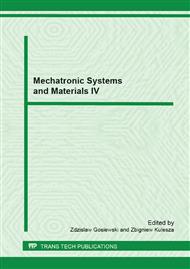p.96
p.102
p.108
p.114
p.120
p.126
p.132
p.138
p.144
Pneumatic Robot for Monitoring Hazardous Environments of Coal Mines
Abstract:
The GMRI robot is capable of inspecting hazardous zones of methane and/or coal dust explosion in hard coal mines. The robot enables remote measurements of the concentrations of methane, carbon monoxide, carbon dioxide, oxygen, temperature, and humidity. Cameras enable the robot to observe the state of the excavation. All electronic circuits of the robot, for measurements, control, transmission, and supply, are intrinsically safe. The transmission of data and control commands from/to the operators console are performed via an electric wire. Moreover, the wire enables to transmit intrinsically safe electric energy and is used to charge one of the accumulators. Thanks to that, the robot can operate in an isolated excavation for 3 months. An intrinsically safe pneumatic drive has been applied for setting wheels in motion. The non-commercial robot prototype was tested in a real excavation in an active hard coal mine. The technical solutions have been presented in the paper.
Info:
Periodical:
Pages:
120-125
Citation:
Online since:
March 2013
Authors:
Price:
Сopyright:
© 2013 Trans Tech Publications Ltd. All Rights Reserved
Share:
Citation:


